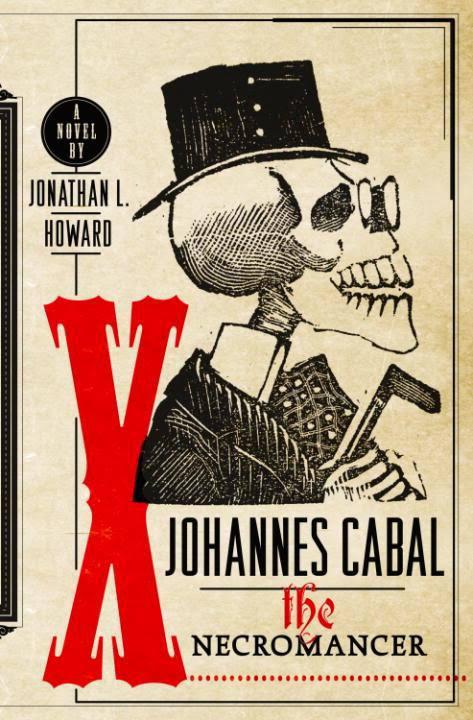Halloween is closing in, and while children gear up for a night of sugar dressed in wrappers and sticks, the few who still adhere to the true nature of Halloween crave the macabre: the venture into the demonic, the dark and morbid humor that provides the counterweight to the sunny side of life. For those of you with a taste for fangs and pitchforks and aren’t satisfied with commercialized television specials like “American Horror Story” or “Scream Queens,” “Johannes Cabal: The Necromancer” by Jonathan L. Howard is the gothic novel that demands to be read by candlelight on All Hallows’ Eve.
The plot is simple enough. A scientist aims to cure death. What seems at first to be the premise of a science fiction novel actually dives into fantasy, as the novel’s protagonist, Johannes Cabal, a necromancer of some infamy, seeks every means of reaching his goal, and doesn’t stop at the edge of science. He goes so far as to strike a deal with Evil Incarnate, Satan, to sell his soul for the powers of necromancy, or the ability to raise the dead. By the time we meet Cabal, however, he is furious with necromancy’s unreliability and is set on getting his soul back from Satan.
It is in this moment that we join Cabal in his journey and pick up the tone of the novel. Although Cabal is dealing with the forces of evil, his no-bullshit attitude and disregard of the supernatural make him a likeable character. Cabal is unforgiving to anyone who does not serve a purpose to him, mortal or demon, and refuses to put up with anyone else’s own ideas of self-superiority. Thus, when Johannes is in Satan’s throne room negotiating another contract in exchange for his lost soul, he garners this dialogue from the Prince of Lies himself:
“‘Not entirely fair,’ repeated Satan, all trace of jovial hail-fellow-well-met gone. ‘Not entirely fair?’ His voice became that of the inferno: a rushing, booming howl of icy evil that flew around the great cavern, as swift and cold as the Wendigo on skates. ‘I am Satan, also called Lucifer the Light Bearer…’ Cabal winced. What was it about devils that they always had to give you their whole family history? ‘I was cast down from the presence of God himself into this dark, sulphurous pit and condemned to spend eternity here–’ ‘Have you tried saying sorry?’ interrupted Cabal.”
The entire novel is laced this way. Gothic settings and circumstances draw the imagination to ravens and vampires while the narrator’s impatient, irreverent descriptions remove the fear from them. When Cabal enters hell—actual hell—for the first time we are given not only the grand image of the famous gates but how the infrastructure is based on paperwork. “Lots of forms. Stacks of forms,” the novel reads. “An average of nine thousand, seven hundred, and forty-seven of them were required to gain entrance into Hell. The largest form ran to fifteen thousand, four hundred, and ninety-seven questions. The shortest to just five, but five of such subtle phraseology, labyrinthine grammar, and malicious ambiguity that, released into the mortal world, they would have certainly formed the basis of a new religion or, at least, a management course.”
With the deal struck, Cabal has a task to complete: gather 100 souls for eternal torment by running a creepy carnival or lose his necromancy powers and his life to Satan.
While the plot alone is reason enough to pick up “Johannes Cabal,” the title character is the real excuse to leave the TV for an actual book. Howard, either by sheer genius or witchcraft, somehow makes a murderous scientist seem likeable. Cabal is searching for a simple thing: the cure for death, and he is not swayed by obstacles to stop him. When we first find him summoning a demon to get an entrance into hell, we do not find a desperate man begging a demon. We find a calculating, unforgiving doctor whose determination can at times become his superpower.
“‘Lo!’ cried the demon. ‘I am here! What dost thou seek of me? Why dost thou disturb my repose? Smite me no more with that dread rod!’ He looked at Cabal. ‘Where is your dread rod?’ ‘I left it at home,’ replied Cabal. ‘Didn’t think I really needed it.’ ‘You can’t summon me without a dread rod!’ said Lucifuge, appalled. ‘You’re here aren’t you?’”
Whether running a carnival, escaping a false reality created by a rival necromancer, making amends with his vampire brother or shooting a couple of small-time burglars to test a new resurrection serum, Howard still finds a way to make Cabal a sympathetic character. Often you will find yourself keeping score of the souls signed over, rooting for Cabal to get his soul back and continue, with slicing sarcasm, to correct the grammar of his enemies’ medieval villain speech.
These days Halloween has split into the extremely childish, a reason to slather sugar in orange and black food coloring, and the horrific and graphic attempts by Hollywood to scare the crap out of us. But “Johannes Cabal: The Necromancer” splits the spectrum, giving its readers their dose of monsters and wretched characters without forgetting that demons have a sense of humor as well.





